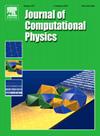Extension of the hybrid WENO5IS-THINC scheme to compressible multiphase flows with an arbitrary number of components
IF 3.8
2区 物理与天体物理
Q2 COMPUTER SCIENCE, INTERDISCIPLINARY APPLICATIONS
引用次数: 0
Abstract
We extend the hybrid reconstruction method combining the fifth-order incremental-stencil weighted essential non-oscillatory (WENO5IS) with the Tangent of Hyperbola for INterface Capturing (THINC) to flow scenarios involving an arbitrary number of fluids. The extended five-equation model accounting for both capillary and viscous forces is employed, maintaining permutation symmetry among fluid components. Within the finite volume (FV) framework employing structured meshes, the WENO5IS scheme, augmented with a positivity-preserving limiter accurately resolves flow structures inside each component, while the symmetry-preserving THINC sharpens the fluid interfaces. Interface regions containing multiple components are decomposed into pairs of interfaces between each involved component, and the corresponding reconstructed volume fractions and phase densities are renormalized before time integration. The inclusion of a generalized continuous surface force (CSF) method enables simulation of capillary effects between an arbitrary number of fluids. One- and two-dimensional test cases involving multiple components are employed to validate the efficacy of the proposed approach in maintaining interface sharpness, achieving high-resolution within individual components, and preserving normalization and positivity properties of volume fractions. Simulations incorporating surface tension and viscosity further demonstrate the applicability of the present model and algorithm in capillary problems within the compressible framework.
求助全文
约1分钟内获得全文
求助全文
来源期刊

Journal of Computational Physics
物理-计算机:跨学科应用
CiteScore
7.60
自引率
14.60%
发文量
763
审稿时长
5.8 months
期刊介绍:
Journal of Computational Physics thoroughly treats the computational aspects of physical problems, presenting techniques for the numerical solution of mathematical equations arising in all areas of physics. The journal seeks to emphasize methods that cross disciplinary boundaries.
The Journal of Computational Physics also publishes short notes of 4 pages or less (including figures, tables, and references but excluding title pages). Letters to the Editor commenting on articles already published in this Journal will also be considered. Neither notes nor letters should have an abstract.
 求助内容:
求助内容: 应助结果提醒方式:
应助结果提醒方式:


